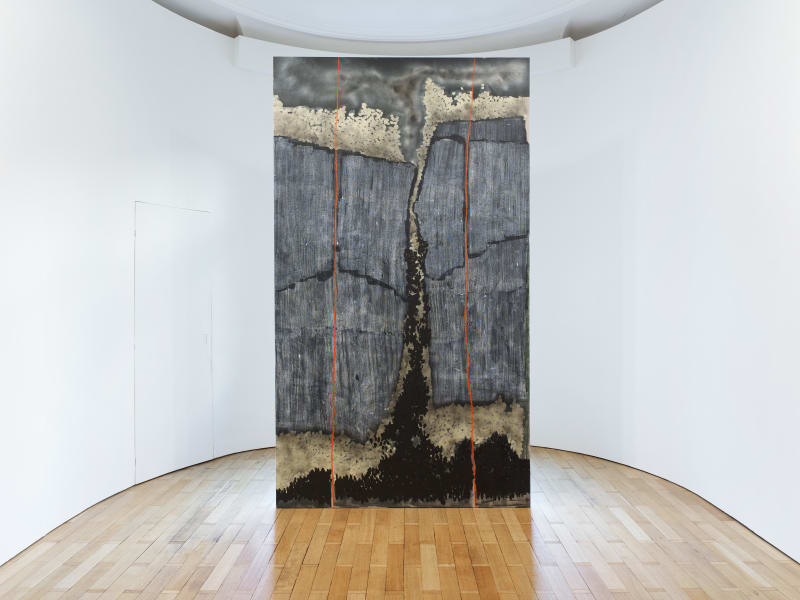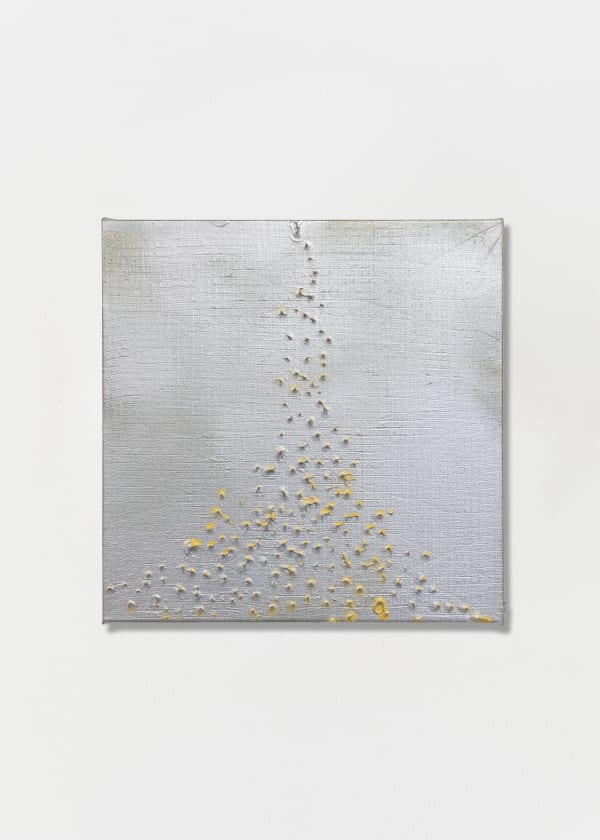Estude fundo Laís Amaral
Estude fundo, the first solo exhibition project of Laís Amaral in Europe, takes over Mendes Wood DM Brussels’ space with newly produced works.
This series of works is Laís Amaral’s experiential and confident marksmanship, conveying her interest in decentering anthropocentrism through a lexicon of codified affective non-figuration. The constellations of signification across different canvases produce a permeable imaginary where a series of relations are advanced through an entanglement of text, subtext and gestures that ascribe the political and social stakes of Amaral’s non-objective abstraction.
Produced through the interplay of scale and tactile dimensionality of the layered painterly approach, these images suggest transfer points of continuity and flow conducted through a lexicon of codes and symbols that reappear across the canvases. The system of delicate stems, tendrils, and orbs traverses angular pathways, on taut and elastic gridded planes, all deployed through a controlled color palette. They produce a conjoined time, a mutual worlding that situates Amaral as the transmitter of a trans-corporeal consciousness, guiding us to navigate structures that seem to bear little resemblance to terrestrial facts.
Through visual saturation and scale, Amaral reduces the distance between the enormity of deforestation and the immediacy of bodies by implicating the viewer in the co-creative relation between knowledge, space and meaning-making. Here, you stand in front of a set of parallel waves, the separation of entities performed by a sliver riding the center of the canvas. Vivid lines pulse through each wave, giving rhythm and movement that start and end on the foamy crest of waves washing upon endless beaches, in a continuous thick space that contains both a sense of humidity and aridity.
There is no suggestion of temporality; the ‘place’ is somewhere already stripped, amid continuities and changes. The ‘when’ of these works is expansive yet expresses a sensitivity to the agency of the vegetal. In Untitled XI, 'Cimento e água, Gamboa' series, through patterning, multiples focal points, and what appears to be an ambivalent horizon, the color and form anchor the field reference, while the branchless stems in their stark environment and the perforating white orbital spores perform a visual lyricism as they descend downward on the canvas.
In Untitled I, 'Sujeito de sua própria enunciação' series, we are made aware of the missing body of the tree. The unaffixed shapes, reminiscent of dried leaves, flow about and between the stark poles as they emerge from a fluid ground and aridly project upward.
The differences in mark registration and coloration in the works make visible the porosity of reading vegetal bodies as archives, cultivating an inherited bifurcated bodily sensibility that seeks to communicate a complex web of historical, political, biological, ecological, and economic enmeshments of knowledges that emerge at the intersection of a politics that recognizes racial and environmental justice.
The Faceira series presents a recognition of crisis, recovery, and disavowals progressively developed across three surfaces that connote a force of irreconcilable oppositions with the registration of the darker underpaints and successive layers of gold. The brushwork of the final canvas has a feverish quality, with the initial layers of black and gold barely breathing under the layer of white paint. Symbolically, the whitening refers to states of despondency, and perhaps further still towards psychosomatic disconnections and dejections.
The strangulated underlayers still pulse through, operating as a metaphor for an animated black exuberance that connotes a sense of social and political resistance against the suppressive supremacy of ideological erasures and whitening. The white membrane does not stay white, as it claims the surface, it too is changed and affected by the pervading layers.
In Untitled IV, 'Fio' series, the viscous whiteness webs across the canvas. The imprecise and asymmetrical distribution of the white paint on the surface suggests the suppression of procreative life in its most elemental form. It is whiteness of a certain kind: that of absences and voids, hollowness and nothingness, emptiness, and oblivion.
We see Amaral’s dexterity in manipulating the viscous porosity of the paint, the arrangement of the paint signifying the physical placements of legitimate and illegitimate violences, communicated in the transmutable variations of the whites, which at other times read as a generative substrate upon which signification can flow and float.
The body of work navigates through sensations, thoughts, and feelings that Amaral wills us to perform as we move through the gallery – a decompartmentalized space between the inner necessity and the feeling manifested through bodily movement in the materiality of painting. The exhibition is a sophisticated gesture towards epistemic recovery and proposes an understanding of porous boundaries within the ever expanding familial, social, planetary, and cosmic relations and processes engendered by natural and cultural ecologies.
— Nkule Mabaso
Laís Amaral's research on the effects of environmental collapse on contemporary society plays an integral role in her artwork. In recent years, she has dedicated herself to observing how we relate to nature and the fragmentation that occurs when the human body is separated from its natural environment.
Finding pleasure in disobeying and contradicting the expectations of abstraction, her paintings create a sensitive language that deviates from a fixed linearity. As an artist and craftswoman, Amaral incorporates a strong relationship to manual making by adding beads and other materials to her canvases, creating textures that become enmeshed with the build-ups, marks, and scrapes that constitute the surfaces of her works.
Laís Amaral (b. 1993, Rio de Janeiro, Brazil) lives and works in Rio de Janeiro.
Her most recent solo exhibitions include No meio do peito um buraco fundo, o mais fundo da cachoeira, onde a luz não vem de fora, HOA Gallery, São Paulo (2023); Laís Amaral: Cement and Water, M+B Almont, Los Angeles (2022); Bebendo Água no Saara, Anita Schwartz Galeria, Rio de Janeiro (2020).
Additionally, her work has been included in group exhibitions as A Defect of Color, Museum of Art of Rio (MAR), Rio de Janeiro (2022); Possible Agreements, Mendes Wood DM, Brussels (2022); Onde se espreitam vias somos aquelas que permeiam o abismo em busca das frestas, Instituto Tomie Ohtake, São Paulo (2021); Manjar: Para Habitar a liberdade, Solar dos Abacaxis, Rio de Janeiro (2019).





















